Cooking sous-vide can be confusing, as recommendations for time and temperature can vary considerably. Personal preference plays a role in this, as well as misconceptions about food safety (i.e. using higher temperatures than necessary). For pork belly I’ve seen recommendations ranging from 7 to 48 hours for time, and 57C/135F to 80C/176F for temperature. I cut a slab of pork belly into 8 pieces, and tried 8 different time and temperature combinations from various sources. None of them came out terrible, but some were clearly much better than others. I will describe them in order of temperature, and end with a conclusion. I would have to do more experiments to come up with the ‘ultimate’ time and temperature combination, but I’m very satisfied with the two best ones.
Here are the 8 pieces of pork belly with supporting ingredients. As you can see it was a relatively lean slab of pork belly, which makes it more prone to dryness.
For about 1.8 kilos (4 lbs) of pork belly I used 1 Tbsp (22 grams) salt, 1 Tbsp ground fennel seed, 1/2 Tbsp freshly ground black pepper, and 1/2 Tbsp garlic powder.
I mixed salt and spices in a small bowl, and spread this rub evenly on all sides of the pieces of pork belly.
Then I vacuum sealed them and labeled them with the various time and temperature combinations I wanted to try.
The piece to be cooked at 57C/135F needed to be submerged in hot water for 10-20 seconds after vacuum sealing to kill any lactobacillus on the surface of the meat. The water needs to be at least 77C/170F. This procedure is required to prevent a bad smell when cooking below 60C/140F.
After cooking sous-vide, I seared the pork belly in a very hot frying pan with just a bit of oil.
I reduced the bag juices and served them alongside.
57C/135F for 48 hours. Very good: tender and juicy. As you can see only a bit of the fat has rendered (it floats on top of the juices). 8.5/10
60C/140F for 48 hours. Tender but not as juicy as at 57C/135F. 7.5/10
64C/144F for 24 hours (as recommended by Great British Chefs). Quite dry and only still nice because of the fat. 6/10
68C/155F for 36 hours (as recommended by Serious Eats). Very tender and flaky, but slightly dry. 7.5/10
70C/158F for 16 hours (as recommended by Anova/ChefSteps). Dry and not as tender. 6/10
74C/165F for 24 hours. Tender and juicy. 9/10
77C/170F for 7 hours (as recommended by Anova). Quite firm and slighly dry. 7/10
80C/176F for 7 hours (as recommended by ChefSteps). Quite firm and slightly dry. 7/10
Concluding remarks
Although I would have to try more combinations of time and temperature to be absolutely certain about the ‘ultimate’ combination of time and temperature for pork belly sous vide, it is clear that a longer cooking time provides a better result. Just like I showed in this post, the dryness caused by a higher temperature can be offset by the additional tenderness from a longer cooking time. I expect that at 70C/158F, 77C/170F or 80C/176F better results would have been achieved with a longer cooking time. It also seems that temperatures between 60C/140F and 70C/158F are suboptimal; as my best results were 48 hours at 57C/135F and 24 hours at 74C/165F. Which of those you prefer is a matter of preference: at 57C/135F less fat will have rendered (which you can consider an advantage or a disadvantage) and the meat is not as flaky than at 74C/165F.
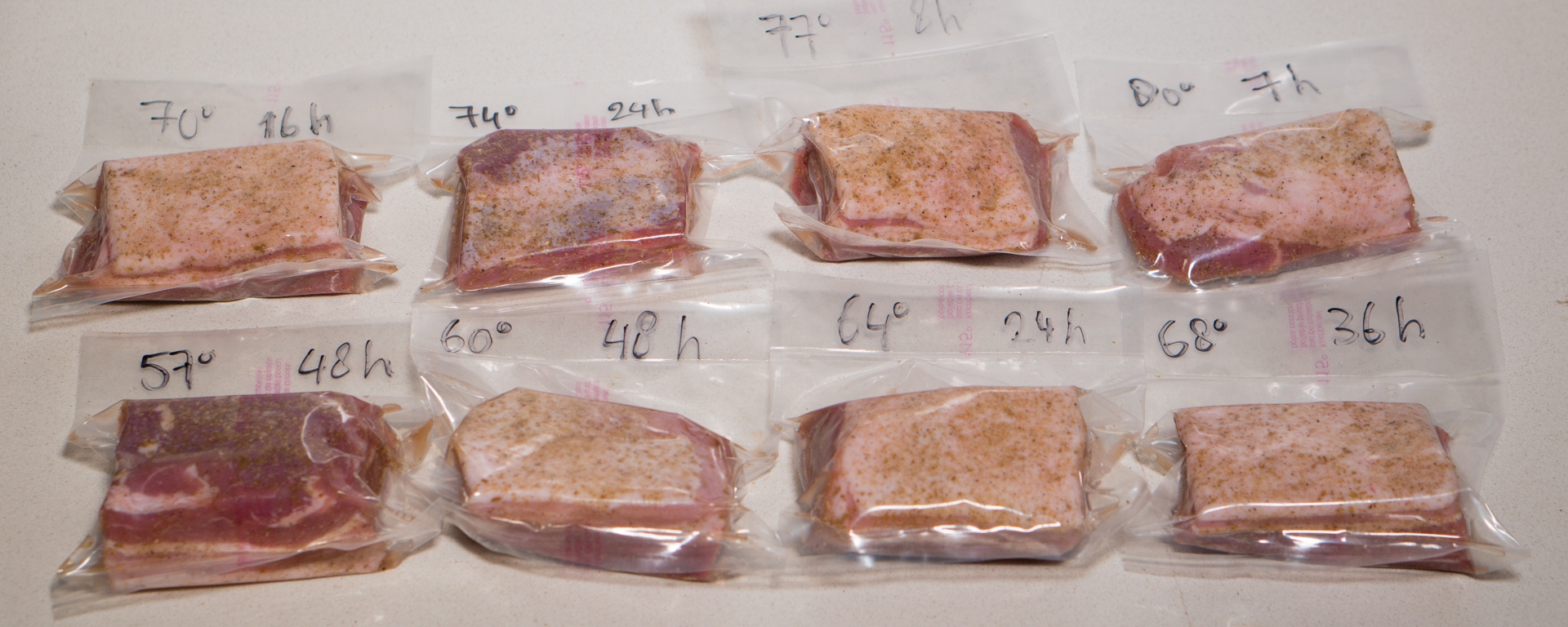
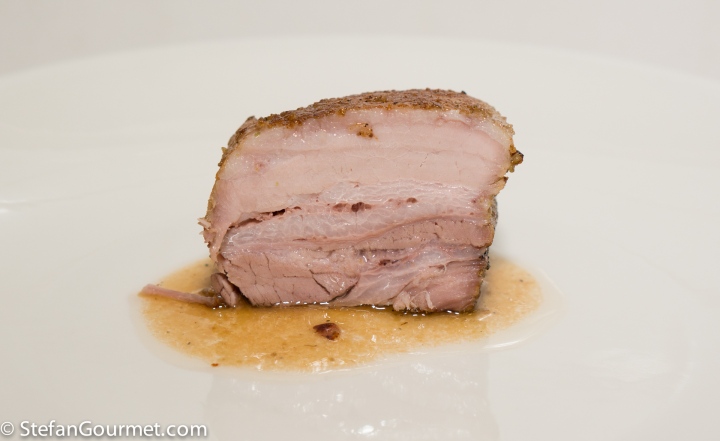

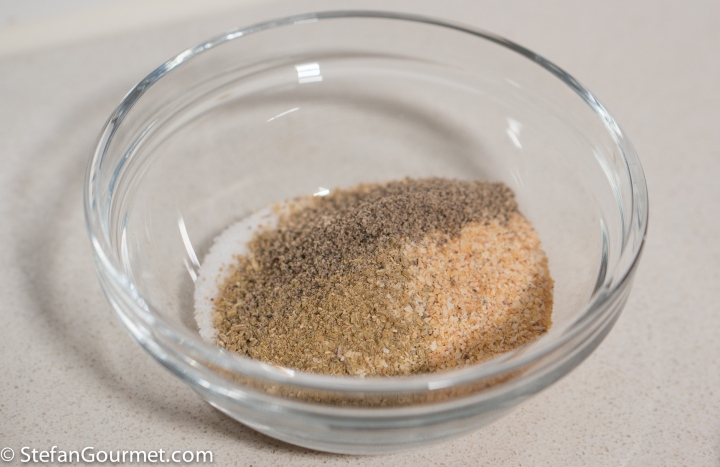
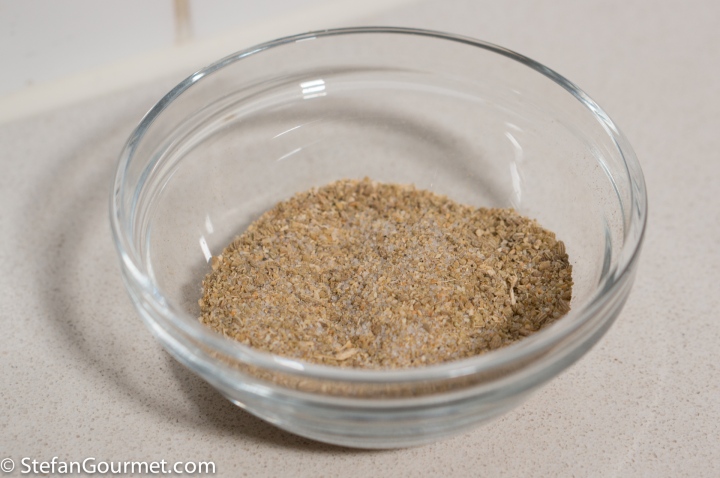



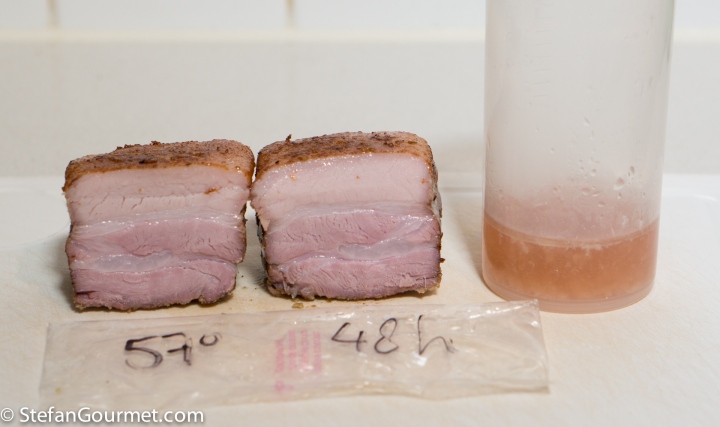

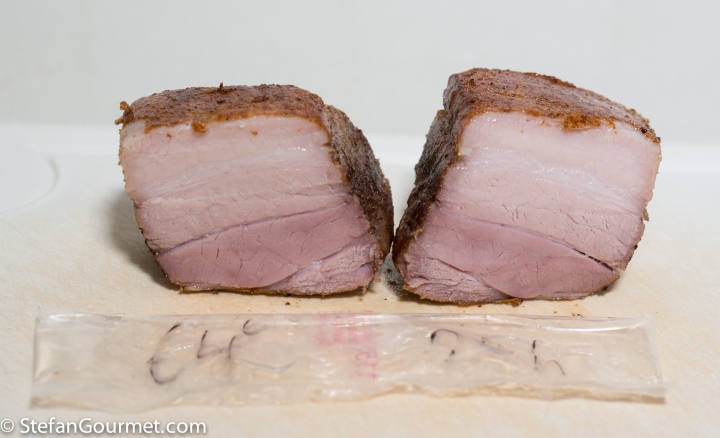
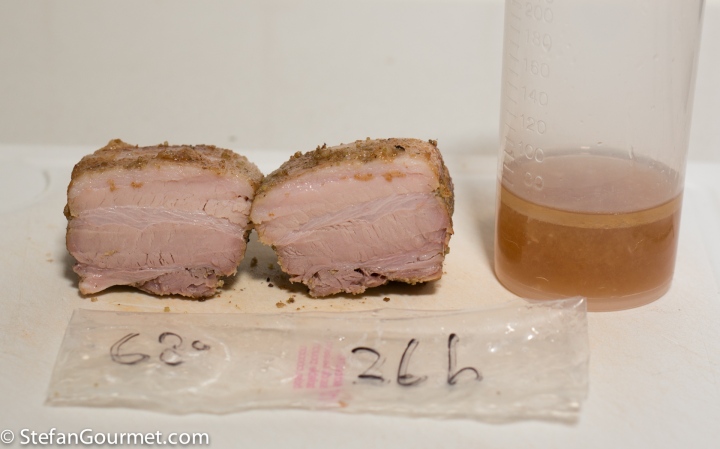

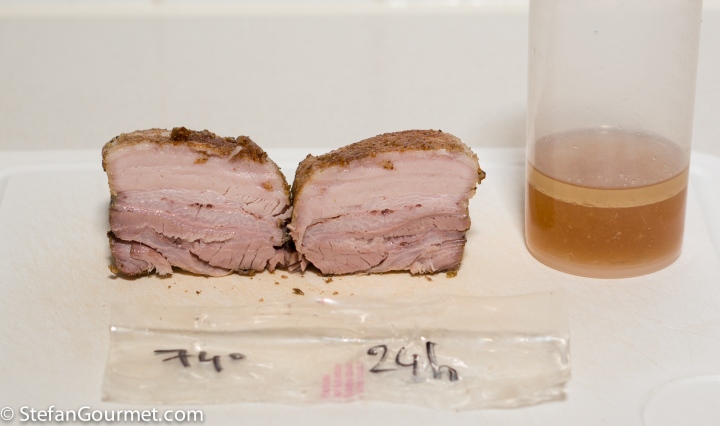



Stefan, you’re a seemingly inexhaustible font of cooking lore. Many thanks.
LikeLiked by 1 person
Thanks!
LikeLike
Great post. I wonder the difference that one might experience through using high quality, free range pork versus the unfortunate supermarket stuff, across the range too. Like so much research, it sets up more research. Great post indeed.
LikeLiked by 1 person
Apart from high quality and free range it would also need to be a breed of pork that has more intramuscular fat (marbling) to get better results, as that intramuscular fat will make it seem more juicy.
And you are so right; these results make me curious what would happen with longer times at 70C, 77C and 80C. It is interesting though that the recommendations for short cooking times at those temperatures come from reputable sources.
LikeLike
Great post! Thanks for doing is. Maybe we should brine the pork before sous vide cooking at higher temperature? e.g. 80c should be cooked in a bag of soy sauce like a traditional chinese braise.
LikeLiked by 1 person
Hi Dai,
I did add salt. I know it sounds counterintuitive, but any liquid you add through a brine will not keep the meat moist. It is the salt that does. See this article for more information: https://stefangourmet.com/2018/04/02/pork-loin-or-tenderloin-sous-vide-to-brine-or-not-to-brine/
Even with a brine or cure, at 80C more time will be needed for a good result.
LikeLike
Great post. I love these.
I’m wondering why the 70C for 16 hours, turns out more dry than the 74C for 24 hours. Do you have any idea as to why?
BR,
Stig
LikeLiked by 1 person
I’ve explained this phenomenon in this post: https://stefangourmet.com/2019/01/05/beef-blade-steak-sous-vide-time-temperature-experiment/
If you cook meat to a high temperature (above 65C/149F or so), it will initially contract and become very firm (and appear dry). It will then take a long time for the connective tissue to break down so the meat can relax again. 16 hours is simply too short. I expect that with 24 or 36 hours at 70C, the result will be a lot better. In my experience most meats turn out best either for 24-36 hours at 55-57C (firm but tender), OR for 24 hours at 74C (flaky). Anything in between is usually a disappointment (although lamb shank or veal shank is good at 62C).
LikeLiked by 1 person
Higher temperatures and longer times gelatinise the fat, which adds a different type of moistness. But don’t go too high, better to find perfect balance of greasy flavour type moistness, without without losing too much runoff.The runoff size and moistness from water but runoff fat reduces flavour.
LikeLike
Good solid info. As a novice sous vide cook, I’m frustrated by the variation in time and temp you find online. Pork belly is on my radar screen to cook so your post is timely. I’ll be giving your 74C/165F for 24 hours cook a try. Thanks for going to the trouble to experiment and share your results.
LikeLiked by 1 person
You are welcome. I understand the frustration; it is through 8 years of trial and error that I have build up my experience and now usually know what time and temperature combinations will and won’t work. Often temperatures are too high and times too short. By now you should be able to find reliable time and temperature recommendations for most stuff you would ever want to cook sous vide on this blog, but let me know if you need any help.
LikeLike
agree with both- thanks stef so much for all this (sort of ruined a batch of sous vide rhubarb last week – sources vary sooo much/it is just acceptable for some fruit, but with meat and fish the whole thing becomes frutstating and that is why perhaps I use sous vide only for yogurt and creamy desserts— sad, I know 🙂 )
LikeLiked by 1 person
Excellent post and very helpful. I will follow your results/advice when I next prepare pork belly. Your experiment took a lot of effort and time. I appreciate your working knowledge of this popular meat.
I wonder if beef brisket is another dense meat that might also benefit from this treatment? It is normally smoked “low and slow” and can be difficult to do well.
Great post and thanks for your work.
LikeLiked by 1 person
Perhaps no surprise, but in my experience 48 hours at 57C/135F or 24 hours at 74C/165F are also good options for beef brisket. To get a smoky flavor smoke before cooking sous vide, but make sure the core temperature does not exceed the intended sous vide temperature. See also https://stefangourmet.com/2012/12/23/smoked-brisket-sous-vide/. If you want ‘bark’, pan sear afterwards.
LikeLike
Thank you for doing this grunt work but necessary experimentation so the rest of us can be assured it will work
LikeLiked by 1 person
I can assure you that my husband did not mind being the guinea pig for this experiment 🙂
LikeLike
Dag Stefan
As usual your meaning is based (much) more on facts than most others because of your research. Could this research leads to the ultimate Chinese babi pangang ?
So can you do a follow up, how to create a sous vide ultimate crispy skin pork belly ?
The best taste babi pangang recipe I found is from a Dutchman, also after research: https://www.volkskrant.nl/nieuws-achtergrond/waar-komt-babi-pangang-vandaan~b2bdbf12/
The lost secret is next to five spice powder to add black bean sauce too
LikeLike
Very useful post – many thanks. I opted for 24 hours at 74C with a rub of smoked paprika/oregano powder/seasoning – after having brined for 12 hours (10% brine solution, 5% muscovado sugar) . Removed rendered fat and juices (20% of original weight), re-vacuumed and refrigerated for 8 hours under weights. trimmed into 100g portions. Crisped (had kept skin on – cross hatched) and warmed under 220C fan grill for 11 minutes. Glaze of juices was almost too intense – diluted with white wine and stock. Result was all I could have hoped for – also looked very neat, with identical portions.
LikeLiked by 1 person
Sounds great. You could have skipped the brine. With sous vide it makes less of a difference (and the juices would have turned out less salty).
LikeLiked by 1 person
Good point about the brine – your Lactobacillus tip is a very good one too – before I knew that I discarded a lower temp. batch some while ago thinking it was off. Now, after another trial run, I will be making for 24 people. What could possibly go wrong :-()
LikeLiked by 1 person
Hi, I would like to credit you for a recipe I am writing up on my blog. Is your email address on your blog?
LikeLike
For the credit please link to the appropriate recipe on my blog. What do you need my email address for?
LikeLike
In your sousvide page you are suggesting:
-Pork belly (3 days at 60C/140F for tender and juicy, fat will not render)
In this page you are suggesting:
-My best results were 48 hours at 57C/135F and 24 hours at 74C/165F.
How do you rate the 3 days against the 48 or 24 hours
Thank you for your hard work
LikeLiked by 1 person
Hi, I prefer the 48 hours at 57C/135F because the meat remains more moist. I have so many sous vide posts that I do not always manage to keep everything consistent with my latest insights. Looks like I should do another check. Thanks for pointing this one out.
LikeLike
Very interesting thanks for the post – I have a piece on at the moment at 74c. When I got up this morning a small corner of the pork was just out of the water. No break in the bag just a small amount of juice. I re-bagged it and put it back in with 11 hours cook time to go. Do you feel it will be safe to eat?
LikeLike
It really depends on how much of the pork was out of the water and especially for how long. Since you were cooking at 74C all bacteria were dead, but it’s only pasteurized not sterilized, i.e. the spores of the bacteria are still alive and below 50C they could grow into bacteria again and produce toxins that are not destroyed by the subsequent cooking at 74C. It would take at least 4 hours for anything dangerous to occur. If it was a very small piece it is very unlikely that the temperature in that piece dropped to 50C or less.
LikeLike
Thanks – It was fine we ate it. Another question on cooking time… I was super happy with the fat but found the meat too dry. It wasn’t succulent like we like. Any suggestions on trying a different temp/time for the next cook?
LikeLike
Yes, try the 24 hours at 57C (and don’t forget the scalding step). The fat will render less though, so there is a bit of a trade off.
LikeLike
Hi Stefan,
I made your pork belly yesterday. 23 hours at 74 degrees. After cooling and pressing into shape with 10 kgs weights, portioned,cut crosses into fat and warmed in a frying pan to render off the fat. Slowly raised temperature until the fat side was golden brown and crisp. It was seriously the best pork belly I’ve ever eaten ! Thank you so much for your fantastic experiment. Carry on the good work !
LikeLiked by 1 person
That is great to hear, Cindy! Thanks for letting me know.
LikeLike
Damn it, i was all set for 7 hours at 77c, now I’m going 24 hours at 74c. Finishing with a korean sauce and on the Konro grill. Can’t wait.
Brillaintly useful info so thank you for all the testing.
LikeLiked by 1 person
Thank you ! It means that 1.8kg was divided into 8 parts, right? (Approx. 230g each) I am curious if there is any difference depending on the weight. Thank you so much for the good experiment !
LikeLike